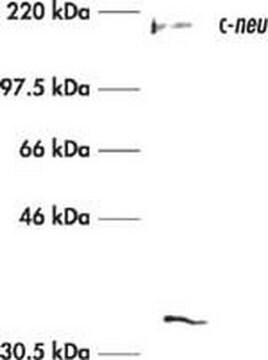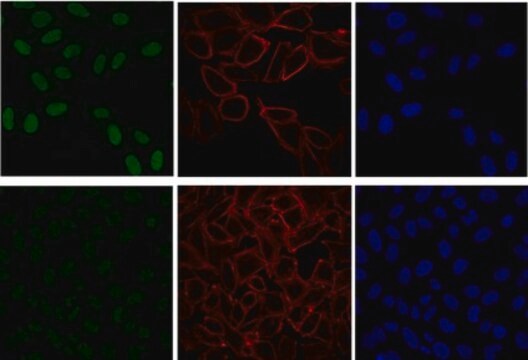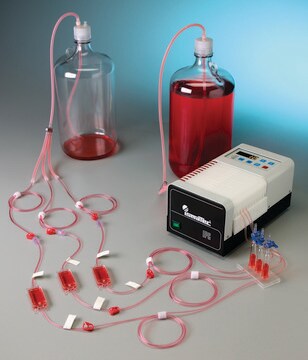おすすめの製品
詳細
Anti-c-Abl (Ab-3), mouse monoclonal, clone 24-21, recognizes the ~145 kDa human and ~150 kDa mouse c-Abl. It is validated for Western blotting, immunofluorescence, and immunoprecipitation.
Purified mouse monoclonal antibody generated by immunizing BALB/c mice with the specified immunogen and fusing splenocytes with p.3U1 mouse myeloma cells (see application references). Recognizes the v-Abl, the ~145-150 kDa c-Abl, the ~210 kDa Bcr-Abl (CML), and the ~190 kDa Bcr-Abl (ALL) proteins.
Recognizes the ~145 kDa human c-Abl, the ~150 kDa mouse c-Abl, v-Abl, and the Bcr/Abl translocation products in ALL (~190 kDa) and CML (~210 kDa). Does not inhibit protein tyrosine kinase activity.Antibody Target Gene Symbol: ABL1 Target Synonym: ABL, AI325092, bcr/abl, C-ABL, C-ABL 1B, CABL1, E430008G22Rik, JTK7, MGC117749, p145Abl, p150, v-abl Entrez Gene Name: c-abl oncogene 1, receptor tyrosine kinase Hu Entrez ID: 25 (Related Antibodies: PK1006PK1013OP19) Mu Entrez ID: 11350 Rat Entrez ID: 311860
免疫原
a recombinant protein consisting of the carboxyl region of v-abl protein fused to TrpE
アプリケーション
Immunoblotting (1-5 µg/ml)
Immunofluorescence (see application references)
Immunoprecipitation (1-2 µg/sample)
Neutralization Studies (not recommended)
Immunofluorescence (see application references)
Immunoprecipitation (1-2 µg/sample)
Neutralization Studies (not recommended)
包装
Please refer to vial label for lot-specific concentration.
警告
Toxicity: Standard Handling (A)
物理的形状
In 0.05 M sodium phosphate buffer, 0.2% gelatin, pH 7.5.
アナリシスノート
Positive Control
K562 (human bcr/abl), HL-60 (normal abl), and ANN-1 (murine abl) cells
K562 (human bcr/abl), HL-60 (normal abl), and ANN-1 (murine abl) cells
その他情報
Does not inhibit protein tyrosine kinase activity. Detects human c-Abl (145 kDa), mouse c-Abl (150 kDa), v-Abl, and the Bcr/Abl translocation products in ALL (~210 kDa) and CML (~190 kDa). HL-60 and NIH3T3 cells contain normal, non-rearranged protein. Antibody should be titrated for optimal results in individual sample types.
Wiedemann, L.M., et al. 1988. Blood71, 349.
Stam, K., et al. 1985. N. Engl. J. Med.313, 1429.
Konopka, J.B., et al. 1984. Cell37, 1035.
Prywes, R., et al. 1983. Cell34, 569.
de Klein, A., et al. 1982. Nature300, 765.
Reynolds, F.H., Jr., et al. 1980. J. Virol.36, 374.
Reynolds, F.H., Jr., et al. 1978. Proc. Natl. Acad. Sci. USA75, 3974.
Witte, O.N., et al. 1978. Proc. Natl. Acad. Sci. USA75, 2488.
Abelson, H.T. and Rabstein, L.S. 1970. Cancer Res.30, 2213.
Stam, K., et al. 1985. N. Engl. J. Med.313, 1429.
Konopka, J.B., et al. 1984. Cell37, 1035.
Prywes, R., et al. 1983. Cell34, 569.
de Klein, A., et al. 1982. Nature300, 765.
Reynolds, F.H., Jr., et al. 1980. J. Virol.36, 374.
Reynolds, F.H., Jr., et al. 1978. Proc. Natl. Acad. Sci. USA75, 3974.
Witte, O.N., et al. 1978. Proc. Natl. Acad. Sci. USA75, 2488.
Abelson, H.T. and Rabstein, L.S. 1970. Cancer Res.30, 2213.
法的情報
CALBIOCHEM is a registered trademark of Merck KGaA, Darmstadt, Germany
適切な製品が見つかりませんか。
製品選択ツール.をお試しください
保管分類コード
10 - Combustible liquids
WGK
nwg
引火点(°F)
Not applicable
引火点(℃)
Not applicable
適用法令
試験研究用途を考慮した関連法令を主に挙げております。化学物質以外については、一部の情報のみ提供しています。 製品を安全かつ合法的に使用することは、使用者の義務です。最新情報により修正される場合があります。WEBの反映には時間を要することがあるため、適宜SDSをご参照ください。
Jan Code
OP20-100UG:
OP20-100UNUG:
試験成績書(COA)
製品のロット番号・バッチ番号を入力して、試験成績書(COA) を検索できます。ロット番号・バッチ番号は、製品ラベルに「Lot」または「Batch」に続いて記載されています。
Shigeru Matsumura et al.
Nature communications, 7, ncomms11858-ncomms11858 (2016-06-14)
Despite theoretical and physical studies implying that cell-extracellular matrix adhesion geometry governs the orientation of the cell division axis, the molecular mechanisms that translate interphase adhesion geometry to the mitotic spindle orientation remain elusive. Here, we show that the cellular
Cong Fang et al.
Cancer research, 70(21), 8299-8308 (2010-09-15)
Oncogenic kinase activity and the resulting aberrant growth and survival signaling are a common driving force of cancer. Accordingly, many successful molecularly targeted anticancer therapeutics are directed at inhibiting kinase activity. To assess kinase activity in minute patient samples, we
Martin Frejno et al.
Molecular systems biology, 13(11), 951-951 (2017-11-05)
Most molecular cancer therapies act on protein targets but data on the proteome status of patients and cellular models for proteome-guided pre-clinical drug sensitivity studies are only beginning to emerge. Here, we profiled the proteomes of 65 colorectal cancer (CRC)
Tamjeed Saleh et al.
Nature structural & molecular biology, 24(11), 893-901 (2017-09-26)
The activity of protein kinases is often regulated in an intramolecular fashion by signaling domains, which feature several phosphorylation or protein-docking sites. How kinases integrate such distinct binding and signaling events to regulate their activities is unclear, especially in quantitative
A M Eiring et al.
Leukemia, 29(12), 2328-2337 (2015-07-24)
Activation of nuclear β-catenin and expression of its transcriptional targets promotes chronic myeloid leukemia (CML) progression, tyrosine kinase inhibitor (TKI) resistance, and leukemic stem cell self-renewal. We report that nuclear β-catenin has a role in leukemia cell-intrinsic but not -extrinsic
ライフサイエンス、有機合成、材料科学、クロマトグラフィー、分析など、あらゆる分野の研究に経験のあるメンバーがおります。.
製品に関するお問い合わせはこちら(テクニカルサービス)






